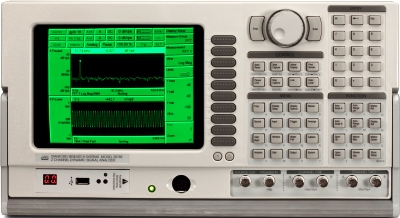
|
|
The SRS SR785 Two-Channel Dynamic Signal Analyzer is a precision, full-featured signal analyzer that offers state-of-the-art performance at a price that's less than half that of competitive analyzers. Building on its predecessor, the SR780, the SR785 incorporates new firmware and hardware that make it the ideal instrument for analyzing both mechanical and electrical systems. For measurements involving servo systems, control systems, acoustics, vibration testing, modal analysis, or machinery diagnostics, the SR785 has the features and specifications to get the job done. Standard measurement groups include FFT, order tracking, octave, swept-sine, correlation, time capture, and time/histogram. The SRS SR785 brings the power of several instruments to your application: a spectrum analyzer, network analyzer, vibration analyzer, octave analyzer and oscilloscope. Specifications. Frequency Range: 102.4 kHz or 100 kHz (both displays have the same range). FFT spans: 195.3 mHz to 102.4 kHz or 191 mHz to 100 kHz. The two displays can have different spans and start frequencies. FFT resolution: 100, 200, 400 or 800 lines. Dynamic range: 90 dB typical, 80 dB guaranteed (FFT and Octave). 145 dB typical (Swept-Sine). Includes spurs, harmonics, intermodulation distortion, and alias products. Excludes alias responses at extremes of span. Harmonic distortion: <-80 dB (single tone in band). Amplitude Accuracy Single channel: ±0.2 dB (excluding window effects). Phase Accuracy Single channel: ±3.0 deg. relative to external TTL trigger (-50 dBfs to 0 dBfs, freq <10.24 kHz, center of frequency bin, DC coupled). For Blackman-Harris, Hanning, Flat-Top and Kaiser windows, phase is relative to a cosine wave at center of time record. For Uniform, Force and Exponential windows, phase is relative to a cosine wave at beginning of the time record. Number of inputs: 2. Full-scale input range: -50 dBV (3.16 mVp) to +34 dBV (50 Vp) in 2 dB steps. Maximum input level: 57 Vp. Source Output Amplitude range: 0.1 mVp to 5 Vp. Amplitude resolution: 0.1 mVp.
|